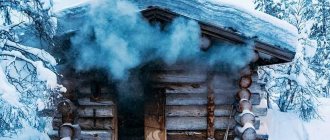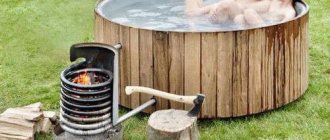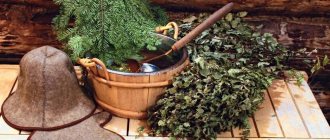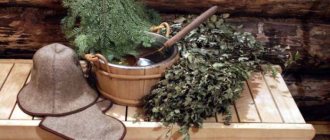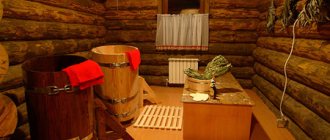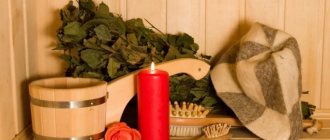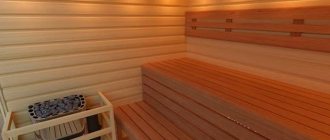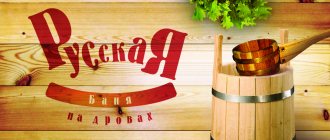In Rus', until the mid-18th century, heating houses using black heat was widespread. Peter I was the first to fight this in the capital of the Russian Empire, banning this method of heating first in St. Petersburg and then in Moscow. But in the vast expanses of our great homeland, peasants and boyars heated such stoves for a long time even after the ban, especially in regions where winters were harsh. But this is not due to the fact that in Rus' there were no craftsmen who could make a stove with a chimney, but for completely different reasons.
Disadvantages of a black bath
The only significant drawback of a black sauna is the need for proper kindling. As mentioned above, when wood burns, carbon monoxide is released. It is important to follow all the rules so that vaping does not harm your health.
Advice! If you need to go into the bathhouse during the kindling, it is better to bend down as close to the floor as possible and cover your head with some kind of cloth. Carbon monoxide is slightly lighter than air, so most of it accumulates at the top of the building.
Otherwise, a black bath can be harmful in several cases:
- Intoxication . Alcohol increases the load on the heart. In combination with heat and high humidity, the “motor” has to work with triple effort.
- Vaping after overeating . The body requires a lot of energy to cope with digestion. But in the bathhouse, metabolic processes are also launched, consuming it. As a result, a person may feel dizzy or even faint from a lack of body resources.
- Presence of diseases . You should not steam if you have hypertension, coronary heart disease, atherosclerosis, or cancer.
- Wet hair . With a wet head, there is a risk of heatstroke, since water accelerates the passage of heat.
But it is worth noting that in the above cases, an ordinary white bath can also cause harm.
Benefits of a black sauna
Thus, a black bath has undeniable advantages:
- Quick heating of the building.
- Savings on construction.
- Saving on fuel.
- Ease of installation. There is no need to even lay boards on the floor.
- Long service life. Such a bathhouse can easily last 15-20 years.
- High temperature and humidity, which provides maximum heating of the body.
- Undeniable health benefits.
Tossing
Manipulations are carried out if:
- the steam room did not warm up well;
- the logs burn too quickly;
- all the fuel from the previous fuel burnt out;
- burning slowed down.
The first firewood should be added 10 minutes after the seed starts burning. Fuel adding process:
- Open the combustion chamber door.
- Use a poker to smooth out the remaining logs.
- Place firewood on top. The ends of the logs should extend beyond the grate.
- Fill the combustion chamber to 2/3 of the total height.
In winter, the bathhouse is heated for about 6 hours, in summer - 3 hours. This time is enough to reach the required temperature and warm up the steam room. The duration of heating depends on the area of the room, the material of the building, the power of the furnace, etc.
At a hardware store you can buy a door for the combustion chamber made of heat-resistant glass. The products look attractive; through the transparent partition you can admire the flames and assess how busy the firebox is.
Types and composition
Himalayan salt is considered a salt stone, the second name of which is halite. It consists of three components:
- table salt;
- chemical microelements;
- mineral impurities.
If you compare Himalayan salt with table salt, it has several features:
- The main component of the composition is NaCl. It contains about 95%. The remaining 5% is a mixture of various chemical components - gypsum, calcium sulfate, etc.
- Himalayan salt is a mass of crystals that is formed under the influence of high pressure.
- Due to its crystalline structure, this substance has a certain level of transparency, but its predominant colors are scarlet, brown, brown and red.
Depending on the method of use, there are 3 types of Himalayan salt:
- Backfilling into the heater. If you pour water on heated stones, a salt cloud will form. It promotes deep cleansing of the skin, but the minerals are quickly destroyed.
- Salt soap. This is a polished piece of Himalayan salt stone. It is used to cleanse the skin during bath procedures.
- Installation of salt lamps inside the bathhouse. Useful not only as decoration, but also for healing.
Multitasking Makes the Brain More Prone to Exploring, But Not Memorizing
What contributes to loss of attention and deterioration of memory?
Some researchers believe that certain neurons in the brain maintain some balance between the states of “exploration” (new content) and “processing” (content for later remembering). However, in a state of media multitasking, as the amount of information the brain is exposed to increases, the range of information people receive visually expands, and the brain is likely more likely to enter an "exploration" state and is able to discover more new information instead of remembering information relevant to the task at hand.
Although the human brain has already undergone a long process of evolution, the way the brain processes information has probably not changed much. Some scientists say that constant exposure to information can have a detrimental effect on the brain in the long term. And some memory training and interventions can help people focus better.
Researchers at Stanford University have come up with a detector that can track a person's pupil, so the device can remind the user to focus on the task at hand. Perhaps in the future such a device will become very popular in schools and among parents.
Why in black?
The bathhouse received this name precisely because of the heating feature.
The smoke that pours out of the fireplace and warms the room settles as black soot on the walls. It eats into the wood forever, and the bathhouse takes on an unsightly appearance. It is no coincidence that foreigners in the old days, who first saw the Russian traditions of steaming, compared the bathhouse to purgatory.
Not only is the temperature prohibitive, but also the walls are black with soot.
Peculiarities
The black sauna was based on one idea - to achieve the fastest possible effect by using the minimum amount of firewood.
Such a structure had to quickly warm up and retain heat for a long time, so that everyone could wash themselves.
From this came the distinctive features:
Room size. This is always a small building, even the ceilings should be low.
The window must be insulated. Currently, double and triple glazing is installed.
Small door. There is a tradition of placing a black door in the bathhouse even below human height.
The hearth is built directly in the ground, and not on the wooden floor of the building. Most often, it is lined with bricks for safety.
Firebox material. Logs from deciduous trees containing little resin are used. They should produce intense heat, and at the same time not emit sparks when burning. Oak, aspen, linden, alder are suitable. But opinions about birch are divided. Some advise heating only with it, while others, on the contrary, recommend avoiding such logs due to the fact that birch smokes heavily. In any case, there is one rule - the firewood must be very dry.
The stove is located in the corner near the exit. If you suddenly need to enter the room during the fire, this location is most convenient. You can quickly add firewood and do not go deep into the room, otherwise there is a risk of inhaling carbon monoxide.
The water container is placed next to the stove. She manages to warm up perfectly in the allotted 2-3 hours. Sometimes the barrel is placed directly on the hearth, but this is overkill. The water will literally boil and an impressive amount will evaporate.
On a note! It is better to insulate the ceiling too. For example, Ivan Boyarintsev, the author of the “Living Bath” project, suggests doing this using birch bark, laid with the light side down, and expanded clay.
More about kindling
A useful advantage of a black sauna is the reduced heating time. This takes about 3 hours, depending on the size of the building.
Firewood is laid at least twice. After the first approach there is always a large amount of smoke, but that’s how it should be. When the stones warm up better, there will also be less smoke.
After the room is warmed up:
- The fire is being put out.
- Burnt logs and coals are removed from the premises.
- The building is ventilated from smoke.
- Sometimes they immediately spray the walls and ceiling with water to avoid washing.
Important! It is necessary to ventilate the room, because carbon monoxide is released during kindling. Breathing it is dangerous to your health!
After 20-30 minutes you can begin bathing procedures. In a properly constructed sauna, the heat will remain for about two hours.
Even the stones are special
Any stone for a black bath is not suitable. Since it must withstand the intense heat from the stove, a volcanic stone is ideal.
For example, jadeite. But not every amateur can afford such a price tag.
The solution was found a long time ago.
In the old days, ancestors chose stones like this:
- They went to the river bank and took away the washed stones.
- They made a fire and placed stones directly inside. Those that burst were immediately thrown away as unusable.
- Then the fire was filled with water. Another batch of stones burst, and they were also sifted out.
- Those that remained and were used.
There was another way.
At dawn, when the dew fell, they went to collect stones. Only wet ones were selected, dry ones were never used. The essence of this selection method is as follows:
If the stone is not covered with dew, it means it has cooled down overnight. But the stones that managed to retain the heat accumulated over the previous day, according to the laws of physics, were covered with dew. They became the best guides.
Expert opinion
Lovkachev Boris Petrovich
Bath master who knows everything about steaming
In Siberia, where the black sauna is especially popular, ordinary pebbles are used for kindling stones. It serves well and does not burst.
How to properly heat a sauna with a metal stove
A bathhouse with a metal stove is different from a classic one. It has a direct-flow type of firebox. This means that the smoke goes straight into the chimney. There is a “labyrinth” inside. The longer it is, the more heat will remain. The draft must be properly adjusted so that smoke does not enter the room.
A metal stove requires a sufficient amount of oxygen, then heat transfer will be maximum. Additional air enters the top of the oven.
You need to heat a metal stove with thin, dry firewood, paper or birch bark. Ignition fluid is not recommended.
First they lay the paper, then sprinkle a few small chips on top and a few medium logs on them. In order for the draft to be maximum, you need to open the blower door and the damper. Set fire to the paper, close the ash-burner after the stove flares up. Load firewood as it burns and little by little. The firebox should not be filled completely. This can affect the combustion process and the service life of the stove itself.
The metal stove must be heated throughout the entire bath procedure. The firewood should burn slowly, maintaining the temperature.
You cannot use coal, coniferous wood or poorly dried logs as fuel. Soot quickly forms in the chimney pipe.
You can use wood from birch, alder, oak, aspen and fruit trees.
Important! A metal sauna stove is a fire hazard. The operating instructions and fire safety precautions must be strictly followed.
How to light a sauna
Place paper in the firebox and dry small firewood on top. Instead of paper, you can use dry fuel, birch bark. This will speed up the kindling process. On top of the small firewood are small logs, and on top of them are some more wood chips. Then you should set fire to the paper or bark and close the oven door.
After a few minutes, check to see if the wood has caught fire. If not, repeat the kindling procedure.
If everything went well, close the flood door to allow air to pass through. Open the valve that releases the heat to the heater and the boiler, and push the valve that leads into the chimney a little.
Attention! Never use plastic or old clothes for kindling. They can produce toxic smoke and cause poisoning. Care must be taken to ensure that the fire does not go out
Periodically add new firewood, pushing the old ones deeper into the stove
It is necessary to ensure that the fire does not go out. Periodically add new firewood, pushing the old ones deeper into the stove.
It is also important to monitor the water level in the boiler and top it up when it evaporates. Adjust the damper that leads into the chimney from time to time so that the bathhouse does not fill with carbon monoxide
When all the wood has burned out and become coals, open the chimney completely. There should be only smoldering coals inside, the water in the cauldron should boil. And the temperature in the steam room is 90-100 degrees.
The bathhouse is heated, you can begin bathing procedures.
How long does it take to heat the sauna?
There is no identical time for heating a bath. It all depends on the time of year, the type of bathhouse (stone or metal), the size of the room, how much water is heated in the boiler and the quality of the firewood itself.
A brick oven takes 3-4 hours to heat in summer and 5-6 hours in winter. Metal – 50-70 minutes in summer, 60-80 minutes in winter.
The ideal air temperature in the steam room can be considered 60 degrees, and air humidity – 60%.
Preparing the stove for firing
The preparatory stage is considered the most labor-intensive:
- We clean the firebox and ash pan of the stove from old coals and ash. It is necessary to completely clear the path for air to combustible fuel.
- Do not forget to check the presence of water in the boiler and its supply for washing. It is strictly forbidden to heat the stove without water.
- Open the smoke damper and the blower door completely. The heating of the sauna must begin with good draft in the chimney.
To properly fire the furnace you need a seed:
- We place birch bark or several crumpled newspapers on the grates, and on them 4-6 thin logs for kindling. Firewood must be laid with gaps so that air can pass freely between the firebox material. You can lay logs using the common “well” method.
- It is advisable to place a pile of wood chips on newspaper inside the firewood structure. Such a seed should flare up the first time.
Specifics of the firebox of a wood-burning bathhouse stove
Technology of heating a brick stove in a bathhouse with wood
We carry out the combustion according to the following algorithm:
- Place two logs parallel to each other on the grate. The distance between them should be about 10 cm.
- Place crumpled sheets of paper between them. If desired, sprinkle them with wood shavings.
- Place two more logs on top and set fire.
- We close the firebox door and leave the ash pan slightly open.
- After 15 minutes, add firewood. It is better not to throw them in a chaotic order, but try to place them as evenly as possible, closer to the doors, having first leveled the coals with a poker. There should be about 25 cm from the top layer of logs to the top of the fuel chamber.
- We will add the next batch of firewood in about an hour. On average, a steam room is heated for about 3-6 hours. All this time you need to constantly monitor the temperature in the steam room. At 60 degrees, you can start steaming the brooms.
- At the end of heating, close the door of the firebox and ventilator, and on the contrary, open the valve completely. This should be done when the temperature of the steam room is above 60 degrees, the stones are hot, and the last portion of firewood thrown in has burned to red coals.
- We open the windows and doors to the steam room wide, quickly rinse the walls and stones with boiling water. A properly constructed bathhouse will not have time to cool down during this period.
- We close the doors and windows, but leave the steam room window open.
- Let the bath brew, warm up and dry for one and a half to two hours.
Please note that before heating in the steam room, you need to fill all wooden products (basins, buckets) with water. Otherwise they will dry out quickly.
Features of heating a metal stove with wood
- We burn some wood chips or a few crumpled sheets of paper in the firebox. This is necessary to warm up the chimney to prevent the appearance of smoke when igniting.
- We stack the firewood in rows or in a cage. It is advisable to maintain a distance of about 1 cm between them.
- For uniform combustion, leave 2 cm of free space on top.
- We place crumpled paper and wood chips under the bottom row.
- We open all the oven doors and set fire to the paper.
- Close the firebox door and open the vent after the firewood has completely ignited. The valve should be left half open.
- After the firewood has burned out, we stir it with a poker and place a new portion in the center of the firebox closer to the door.
- At a temperature of 50-60 degrees, we stop adding firewood and gradually close the valve to reduce heat loss. At this time, the steam room will warm up to maximum temperature (infuse).
Please note that it is better to add firewood to a metal stove more often, but in smaller portions. In this case, you will be able to fully control the temperature and prevent overheating of the metal.
What is the difference?
The main difference between both types of baths is the structural features of the building.
As mentioned above, the old baths had only one window. In many cases, they did without it, making a small hole in the ceiling or simply opening the door slightly.
Everything is wrong in the bathhouse. There must be a chimney through which the smoke comes out. In addition, it is melted in a real oven. There is always a waiting room.
In a black sauna, the hearth is located directly in the steam room. A large number of stones are placed on it. Thus, when the wood burns, it heats the stones. The smoke goes directly into the steam room and evenly warms the entire room.
Often in such baths there is no waiting room. Sometimes they simply put the fifth wall as a partition. But in the old days, peasants, for example, undressed right at the entrance.
Myths
Many people believe that in such houses the entire ceiling, walls and residents were black with soot, but this is far from true. Heating “black” is a real skill. It is necessary to maintain the correct burning rate of wood. Thin chips of alder, pine or aspen were used for kindling, and when the stove flared up, logs of spruce or birch were added. In a proper hut, soot accumulated only at the top lintel or near a special “top”, a place that was closed with a special valve.
The second myth is related to the fact that in Rus' there were no craftsmen capable of coming up with a different stove design, but as we see, such a stove was a necessity for that time. It is worth noting that now some baths still use the black fire method.
Causes
The history of any state proves that no matter how wild the way of life of that time may seem to modern society, everything had its own reason, and so it is with chicken stoves.
We all know that Siberian winters are very harsh and a lot of heat is needed to maintain a constant temperature in the house, so houses were built of wood, not brick, and stoves without a chimney. In a Russian chicken stove, the smoke came out through a special fiber window on the roof and along the way gave off all the heat to the house. Such stoves required less wood to heat the hut.
In addition, the smoke helped to disinfect the air , which in those days was a matter of life and death, since there were no antibiotics. But they performed another role - smoking food, and this is how our ancestors killed two birds with one stone, and heated the house and prepared food.
Another reason for using stoves was the issue of fire safety. Most houses had a thatched roof, and in dry weather the slightest spark was enough to ignite it. In the smoking huts, the smoke went out into the street completely cooled and did not cause fires.
How to light a stove with raw logs?
Kindling stages:
- Chop the raw logs into slivers.
- Place them together to form a cone.
- Place crumpled paper or shredded bark inside.
- Open the furnace vent to maximum.
- Light a torch and use it to light paper or bark.
- Open the blower door to maximum.
The stove needs to be melted with wood chips for 15 minutes. After this you can add small sticks. Logs are added when there are enough coals and the walls of the oven are warmed up. To speed up the kindling, it is recommended to use a liquid ignition composition.
To ensure that moisture leaves the wood faster, raw logs must first be sprinkled with salt. Wait 10–15 minutes, clean off the salt. After this, you can start lighting the stove.
If wood is stored outdoors, logs or hemp should be laid out in rows so that adjacent rows do not touch each other. They should be located under a canopy. The edges can be covered with thick plastic film to protect from slanting rain.


